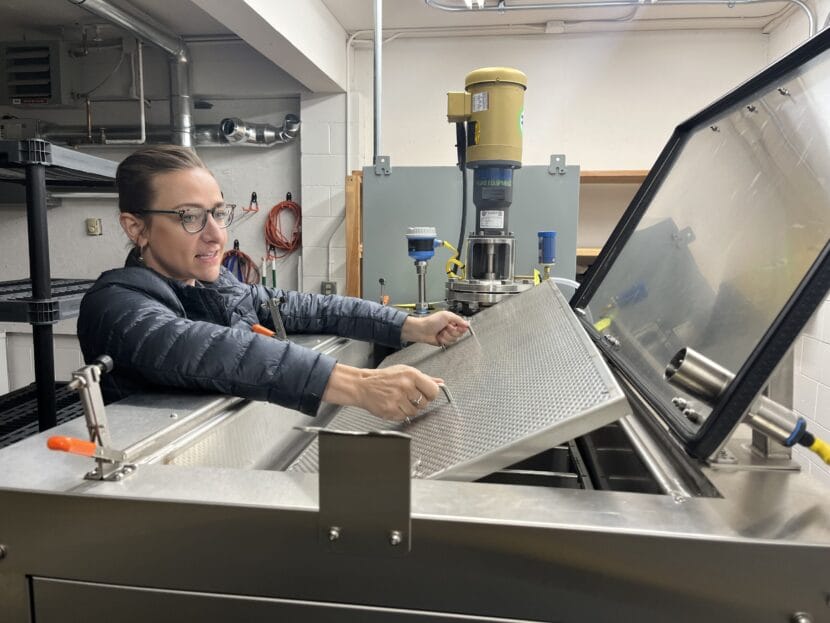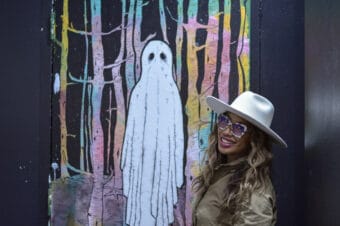
In a warehouse in Anchorage, Rachel Bernhardt gently lowered the body of a Pomeranian named Wiley into a metal chamber.
Wiley was a beloved family dog, known for being feisty and, as his name suggests, wily. He was 17 when he died.
Bernhardt sprinkled rose petals around his body and lowered the platform down with a chain pulley. In the next chamber, she poured in a bucket of white powder–potassium hydroxide, a highly alkaline or basic chemical.
This was the process of “water cremation” or “aquamation,” which uses fluid to break down the body instead of heat. Bernhardt closed the lid, turned on the machine, and it filled with water.
In about 18 hours, Bernhardt will come back to finish processing the remains. They’ll be dried and put in a container for the dog’s family.
Bernhardt recently started doing water cremations for pets in her new warehouse space in Anchorage. The conventional death-care industry uses lots of chemicals, plastic and energy. But nationally, a movement toward natural burial, body composting and low-energy cremation is gaining ground. Bernhardt is passionate about offering some of those choices to people in Anchorage, starting with pets. She said the potassium hydroxide accelerates the water cremation process.

“It’s generally regarded as a gentler process than flame cremation and it’s a more energy-efficient process as well,” Bernhardt said.
Bernhardt worked for many years in organ and tissue donation programs, so she learned a lot about the intersections of health care and death care. She said her experience with the death of a family member was a turning point for her.
“What was missing was the hands on component because a lot of it happens behind closed doors,” Bernhardt said. “You know, your loved one is whisked away and the next time you see them is when they have makeup on, and they’re all done up. And then you go back a couple days, weeks later and pick up an urn. And that’s kind of your only interaction with that process. So it felt very disjointed.”
Bernhardt found solace in a national movement toward natural death care that began in the 1990s. The movement pulled from longstanding cultural traditions of natural burial that had been displaced by contemporary western death practices, though in rural Alaska, many villages do not embalm their loved ones, and instead bury them in simple wooden caskets. Green burials have become more available nationwide in recent years, but not in urban Alaska.
Bernhardt is quick to say that making choices around death is personal and there’s not one “right” way, but she’s doggedly pushing for people to have choices beyond conventional burial and cremation. She calls it an “obsession.” She also helps organize a regular meetup in Anchorage called a “death cafe” to talk about death and the choices people have around it.
“I wish more people could have a quiet moment with themselves and realize that the things that we find taboo, like talking about death–they’re really cultural,” Bernhardt said. “That’s not the way it needs to be.”
Bernhardt is dreaming big. Besides starting a water cremation business, she’s also working to create a natural burial cemetery in Anchorage. Bodies there won’t be embalmed before burial and they’ll be wrapped in a simple canvas cloth or “shroud,” instead of a coffin. She said a natural cemetery holds far fewer bodies than a regular cemetery.
“That low density natural burial as bodies naturally decompose, actually serves as nutrients to the ecosystem there rather than a source of pollutant,” Bernhardt said.
Bernhardt knows that she’s at least a couple years out from being able to bury someone in the natural cemetery she’s creating, but so many people were interested that she created a waitlist.
Stephanie Zaborac-Reed was one of the first people to join the waitlist. She lives in Fairbanks and is in her 60s. She said she was attracted to natural burial because she has a strong aversion to embalming. When she was 20, her father died and she said seeing him embalmed was disturbing.
“You don’t look a thing like you do when you’re alive,” Zaborac-Reed said. “I was young enough that it made a huge impression on me at the time. I expected to see my dad and this body in this casket was not anything like him at all.”
Embalming fluids include formaldehyde, which is toxic and a carcinogen, and embalming chemicals are harmful to both the embalmers and the environment after burial.
As Zaborac-Reed aged and started thinking more about death care options, she realized natural burial aligned with her values. She and her husband hope to be buried at the cemetery Bernhardt is creating.
“It just seems the gentlest of the alternatives and I’m conscious about the environment,” Zaborac-Reed said. “I don’t want to be polluting. I don’t want to be wasteful. I like the gentle approach.”
Bernhardt’s natural burial cemetery will be what’s called a “conservation burial ground.” She imagines a park where you’re more likely to see wild flocks of birds than a headstone. The grave markers will be much smaller than a typical cemetery.
“It’s better for the community, better for the planet, better for people,” Bernhardt said. “It’s a hands-on experience, burying somebody in a natural burial cemetery; if you want to use a shovel and help, that’s welcomed and encouraged.”
Bernhardt believes there’s a lot of interest in natural burial and cremation methods in the state, though she knows offering new options will take time. She’s currently waiting for approval from the city for the tract of land she’s identified near the Rabbit Creek neighborhood in Anchorage. But once more options are available, she hopes it will change the way people feel about death.
